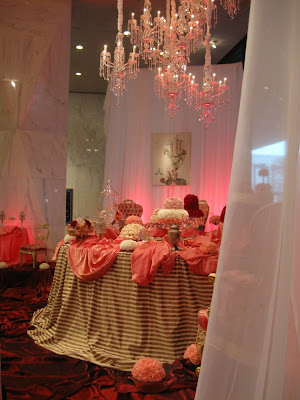I'm going to share a few more photographs of New York in Bloom 2012 before I get back to business as usual around here. I hope you've enjoyed getting the chance to look at the flowers -- a rare thing in New York in February -- and the exhibits that my colleagues at the State Museum have created.
The Bird Hall, which connects Metropolis Hall and Adirondack Hall, features select examples of the State Museum's vast collection of biological specimens. During New York in Bloom, the Bird Hall is home to what our Governor's significant other would call "tablescapes" -- arrangements of items that create vignettes.
 The tablescape created by Douglas Fisher of Designs by Douglas features an appealingly simply arrangement of pear blossoms and spider mums.
The tablescape created by Douglas Fisher of Designs by Douglas features an appealingly simply arrangement of pear blossoms and spider mums. Craig Waltz Jr. of Fleurlite Floral Designs created a lush tropical tables cape that features hala, phalaenopsis orchids, heliconia, eccheveria, roses, palm leaves, and ivy.
Craig Waltz Jr. of Fleurlite Floral Designs created a lush tropical tables cape that features hala, phalaenopsis orchids, heliconia, eccheveria, roses, palm leaves, and ivy. Barbara Guyette, Charles Guyette, and Linda Savage of All the Right Ingredients created this Beatrix Potter-ish Easter tablescape, which features fleurette mums, roses, spray roses, statice, German statice, mini carnations, alstromeria, spider mums, leather leaf fern, cedar, and pine.
Barbara Guyette, Charles Guyette, and Linda Savage of All the Right Ingredients created this Beatrix Potter-ish Easter tablescape, which features fleurette mums, roses, spray roses, statice, German statice, mini carnations, alstromeria, spider mums, leather leaf fern, cedar, and pine.The Crossroads Gallery sits immediately to the south of Metropolis Hall and is used for small temporary exhibits. During New York in Bloom, it was home to Marking Time: Voyage to Vietnam, which featured graffiti drawn on the canvas bunks of the General Nelson M. Walker, a ship that was used to transport soldiers to Vietnam in 1967 and 1968. The voyage to Vietnam took several weeks, and bored, anxious, and seasick soldiers, most of whom were only 19 years old, found that drawing on the bunks was one way to pass the time. The bunks were rediscovered by chance in 1997, and when the ship was scrapped in 2005, the Vietnam Graffiti Project salvaged them and created this traveling exhibit, which until yesterday could be seen at the State Museum.

Christopher Grigas of Hidden Gardens used calla lilies, roses, spray roses, protea, and carnations to create an arrangement that looks like a watery reflection of the life preserver in the exhibit's graphics.

At least some of the men on the ship were from New York State.

An arrangement of roses, seeded eucalyptus, amaryllis, succulents, dubium stars, skimmer flowers, green trick dianthus, cymbidium, and parrot tulips complements life jackets taken from the General Nelson M. Walker. It was created by Marilyn Cederoth of Cedarfarm Wholesale.

I really like this arrangement, which was created by Karen Bucholsky of the Greenport Garden Club and consists of hypericum, agonies, thistle-eryngium, ranunculus, leucadendron, Oriental white lily, Irish, and pussy willow. It brings to mind sea grasses.
Until 31 March 2012, the Photography Gallery features Shadow and Substance: African-American Images from the Burns Archive, which features 113 images portraits, snapshots and photographs documenting industries, properties, and events related to African American history from the mid-19th century to the present day.

In past years, the Photography Gallery has been home to numerous New York in Bloom exhibits. This year, it was home to only one: this elegant composition of roses, mini carnations, galas leaves, and moss created by Michelle Peters of Ambiance Floral Design.
The Exhibition Hall is also home to a wide array of temporary exhibits. At present, it features From the Collections, an exhibit that highlights the State Museum's vast holdings of natural science, history, and anthropology artifacts. I enjoyed this exhibit even more than I initially thought I would, and I encourage you to see it if you find yourself in Albany before 30 April.

This arrangement is actually part of a cluster of arrangements of roses, hydrangeas, and pussy willow that Christine Colpoys of Seagroatt-Ricciardi created to complement the vintage automobile that sits at the exhibit's entrance. (Note the rearticulated mastodon skeleton in the background: Exhibition Hall sits next to a permanent Ancient Life in New York State exhibit.)

This eye-catching arrangement of king protea, wax flower, sago palm, and cactus bones is one of my favorites. It was created by Mary Aiko Bohnet of the Capital District Sogetsu Study Group.

Erin Brady's simple composition of quince, green trick, reindeer moss, and river rocks harmonizes perfectly with a display of Shaker furniture.

This arrangement is another favorite. Unfortunately, its label disappeared sometime before I made it to the Exhibition Hall. I recognize some of its components (monstera leaves, lilies, aspidistra) but not others. The coats on display, all of which either contained the fur of endangered species or otherwise violated federal wildlife protection laws, were seized at John F. Kennedy International Airport by U.S. Customs Officials in 1972. After their investigation ended, Customs officials gave the coats to the New York State Office of General Services (OGS), which, among many other things, oversees the disposition of surplus state government property. OGS then transferred them to the State Museum.
















































